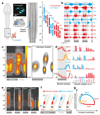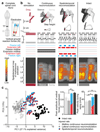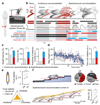Spatiotemporal neuromodulation therapies engaging muscle synergies improve motor control after spinal cord injury
- PMID: 26779815
- PMCID: PMC5061079
- DOI: 10.1038/nm.4025
Spatiotemporal neuromodulation therapies engaging muscle synergies improve motor control after spinal cord injury
Abstract
Electrical neuromodulation of lumbar segments improves motor control after spinal cord injury in animal models and humans. However, the physiological principles underlying the effect of this intervention remain poorly understood, which has limited the therapeutic approach to continuous stimulation applied to restricted spinal cord locations. Here we developed stimulation protocols that reproduce the natural dynamics of motoneuron activation during locomotion. For this, we computed the spatiotemporal activation pattern of muscle synergies during locomotion in healthy rats. Computer simulations identified optimal electrode locations to target each synergy through the recruitment of proprioceptive feedback circuits. This framework steered the design of spatially selective spinal implants and real-time control software that modulate extensor and flexor synergies with precise temporal resolution. Spatiotemporal neuromodulation therapies improved gait quality, weight-bearing capacity, endurance and skilled locomotion in several rodent models of spinal cord injury. These new concepts are directly translatable to strategies to improve motor control in humans.
Conflict of interest statement
G.C., N.W., P.M., M.C., A.L., J.V., M.C., I.M., E.M.M., S.M. and S.L. hold various patents on electrode implant designs (WO2011/157714), chemical neuromodulation therapies (WO2015/000800), spatiotemporal neuromodulation algorithms (WO2015/063127), and robot–assisted rehabilitation enabled by neuromodulation therapies (WO2013/179230). G.C., S.L., S.M. and J.B. are founders and shareholders of G–Therapeutics SA; a company developing neuroprosthetic systems in direct relationships with the present work.
Figures






Comment in
-
Targeted stimulation of the spinal cord to restore locomotor activity.Nat Med. 2016 Feb;22(2):125-6. doi: 10.1038/nm.4043. Nat Med. 2016. PMID: 26845403 No abstract available.
References
-
- Borton D, Micera S, Millan Jdel R, Courtine G. Personalized neuroprosthetics. Science translational medicine. 2013;5:210rv212. - PubMed
-
- Lozano AM, Lipsman N. Probing and regulating dysfunctional circuits using deep brain stimulation. Neuron. 2013;77:406–424. - PubMed
-
- Barthelemy D, Leblond H, Rossignol S. Characteristics and mechanisms of locomotion induced by intraspinal microstimulation and dorsal root stimulation in spinal cats. Journal of neurophysiology. 2007;97:1986–2000. - PubMed
-
- van den Brand R, et al. Restoring voluntary control of locomotion after paralyzing spinal cord injury. Science. 2012;336:1182–1185. - PubMed
Publication types
MeSH terms
Grants and funding
LinkOut - more resources
Full Text Sources
Other Literature Sources
Medical

